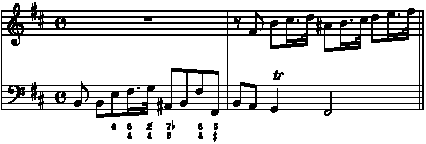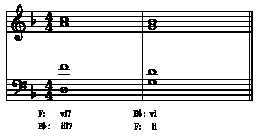27.2. The vertical columns of figures in the print must always be transcribed from the lowest upward.
Example 27.2-1.
.C
;>^?#0_?#0I#0H#0] ]#2$#34"
^:#56$#7 ]#5910:#6<[#6\Y<K

27.1. In transcribing figured bass, the signs in Table 27 only bear their special meaning when the passage in which they occur is preceded by the figured-bass prefix, which is treated in the same manner as that explained for hand signs in Par. 20.1-20.1.2.
27.2. The vertical columns of figures in the print must always be transcribed from the lowest upward.
Example 27.2-1.
.C
;>^?#0_?#0I#0H#0] ]#2$#34"
^:#56$#7 ]#5910:#6<[#6\Y<K

27.3. When figures are printed horizontally, either singly or in columns, the numeral sign must be repeated for every figure or column.
Example 27.3-1.
.C
;>_P#8#7Q#5#6 (#46#35<K

27.4. When the number of figures varies in different columns, dot 3 must be marked for every space not occupied by a figure in order to show the correct horizontal alignment of each figure.
Example 27.4-1.
.C
;>_(#79#'8 %R'#357#''6#'56V<K

27.5. If, as sometimes happens, the print is not always very exact in this matter of horizontal alignment, the transcriber should, nevertheless, follow it faithfully without attempting any correction on his own responsibility.
27.6. If it is necessary to show the rhythmic value of groups of figures above or below a sustained note, stem signs may be placed after the last figure in each column.
Example 27.6-1.
%%.C
;>_Z#59_A#4'_A#38_K<K

(In cases where the print is not clear in this matter, the transcriber must not try to interpret it.)
27.7 (11-97) In print, accidentals are placed immediately before the figures (or in the blank spaces) to which they apply and this rule must be followed in braille even if, as sometimes happens, accidentals are printed after figures. When an accidental is followed by a space in braille, the special sign for "isolated accidental" (Table 27) is not necessary.
Example 27.7-1.
%%.C
;>_:?#%6W#%K[#*3*46<K

27.8. Lines of continuation are treated in the same manner as that indicated for blank spaces (Par. 27.4).
Example 27.8-1.
.C
;>_R#457#3AAN#AAA#3<K

27.9. The following example illustrates the use of the braille signs representing oblique strokes in the print.
Example 27.9-1.
%%_C
;>^OQ RQ#A PR#7 S#/R#34;6 Q#%K%S#7
%^W#/?#%24;6*T@C#AAA )#%K#*K<K

27.10. It is permissible to use the music hyphen between columns of figures, but it must not be used between figures in the same column.
27.11. (11-97) In facsimile copy a distinction should be made between braille music parentheses (Table 17) and small brackets (G.T.). When brackets appear around a single note or feature, use the sign "' ,1 from the General Table, as shown in Example 27.11-1. In non-facsimile transcriptions, music parentheses may be used as in Example 27.11-2.
Example 27.11-1.
%%%#C4
;>_[[? S#6\@C#6 \Q#7#"'%,16<K

Example 27.11-2.
%%%.C
;>^Q#,'3,'W#*6?#%K%5<K

27.12 (11-97) The direction "tasto solo" is placed between word signs, the end of the passage being shown either by some direction such as "accomp.", or by the sign >' representing a slanting stroke in the print.
Example 27.12-1.
<.C
>TASTO SOLO> ;>_G D!)D!)DGDG
_D!)D!)DGD>ACCOMP'_I#6<K

Example 27.12-2.
<#B4
>TASTO SOLO> ;>^:FD 7 EGJH
_D)!HI>' ^O@C#'#7 O#56#';6<K

27.13. In some scores, small notes without stems are added to a figured bass, so placed that their rhythmic values can be seen easily. Such notes should be written with the in-accord sign, and preceded by the sign for notes in small type (Table 17).
Example 27.13-1.
<<#C4
>#L;>^W?#6[#2<>,5":+,5$"-"V
^R'#*K7<9#368#357<K

27.14. The following examples illustrate a figured bass alternating with a solo passage.
Example 27.14-1.
%%.C
D .>'M
;>^JJ_F#6='#46R#4;2%^I#5<7J"
_G#46^G#%K5
E .>'X"GJY'O%"I)'NE&'Q<K
;>^JI6\Q<K

Example 27.14-2.
%%.C
I .>"J.&CY"(=(&G'(F'Z
_>_(=(&DI_EHI^I
AJ .>":VU<K
;>_EDJH#56IHG#6E<K

27.15. The signs for triplet, turns, short appoggiaturas, notes in large type, the shake and mordent, the repeat and the staccato, and accent may sometimes occur in a passage of figured bass. There is no possibility of confusion unless one of these signs immediately follows a column of figures in the same braille line, in which case it must be preceded by the sign: - .
Example 27.15-1.
.C
;>'6_?#6-5)5YW#%6-2I*H#AG#6"
;8^$#%K<K

B. Vertical Format
27.16. The horizontal format of figured bass is recommended when transcribing actual compositions written in this notation. (This has been adequately described in Par. 27.1 - 27.15.) On the other hand, the vertical format is preferable for theory texts, examination papers, and related material where there is the likelihood of a great many more figures being used. This format requires a great deal more space, but is more easily read.
27.17. The first numeral appears directly under the bass note to which it applies, with the remaining numerals in a vertical column as they appear in print. The number sign occurs only for the top numeral of the column, and all numerals are written in the lower part of the cell. Accidentals appearing in conjunction with numerals are placed after the numeral, regardless of the print.
Example 27.17-1.
>#L^R S<K
#9#7
7 5<
3

27.18. Where there is a chord change on a sustained note, the horizontal numbers will be given with one or more hyphens between them, depending upon the number of beats involved.
Example 27.18-1.
>#L_&' Z'<K
#3-6-3 #6-%
4 4

27.19. It will be observed in Example 27.17-1 that there are spaces between the two half notes in order to allow for proper placement of the numerals. Where the horizontal line of figures leaves two or more blank spaces in the bass line, the music hyphen is used to indicate that the measure is incomplete. (See Example 27.20-1.) The end of the measure occurs where there is a space in all lines of the parallel, as in Example 27.23.1-1.
27.19.1. An alternative way to mark the ends of measures is to use the sign for a bar line (G.T.). If this is used, dot 5 is not necessary between notes within the measures. The bar line sign must be preceded and followed by a space. (See Example 27.25-2.)
27.20. (11-97) When chord symbols, indicated by roman numerals, occur below notes, only the single capital sign is used. Roman numerals may be combined with arabic numerals. When this occurs, the arabic numerals should be written horizontally using lower-cell numbers. (Example 27.20-1). These numbers follow without a space, and number signs are used. If a chord symbol, such as a small circle or triangle appears, that symbol is not preceded by a number sign. It is placed after the roman numeral and before the number sign if a number is also present. When parentheses occur in the harmonic analysis, the music parentheses should be used.
Example 27.20-1.
>#L_N T" Q<K
,I,V#56,II#6

27.21. When writing symbols such as V2 and I 64 in a literary text, dots 456 should be placed before punctuation marks that might be read as lower-case numerals. (See Par. 6.5.)
Example 27.21-1.
,"H ! BE/ *OICE IS ! ,I#6_4
Here the best choice is the I6.
This device, however, is unnecessary when a roman numeral is followed by a punctuation mark.
Example 27.21-2.
,=! CAD;E USE ,,II-,V-,I4
For the cadence use II-V-I.
27.22. (11-97) For all illustrations in harmony and theory texts, the intervals should read upward. When intervals occur in the right-hand part, use the prefix .>> (Table 20 (A)). (See Example 27.25-1.)
27.23. In complex excerpts, such as those that would involve in-accords, an open score presentation is preferable.
27.23.1. It frequently happens in the analysis that expressions such as V6 of II occur. These are treated as shown in the next example. Observe that the chords are aligned so that the first sign appears directly under the bass note, and that the practice of blank spaces between bars is disregarded in the analysis line of the parallel. It is also advisable to leave a free line between parallels in material such as this.
Example 27.23.1-1.
%%%.C
A .>"S W1 ? %.O<LV"
.>"P $" ? "R<LV"
_>"N W "$ "Q<LV"
_>_S \%[ %_T<LV"
,I'V#6,V#6 ( ,II,V#56 ( ,III
B'.>'%.: .$" "W W :<K
.> "\ "\'" IHGHF<K
_>'%_W "DE" $ $ $BK
_> _\ "D)! HGFEDJ<K
,V#7 ( ,III,III,V#6

27.24. When the figured bass and the harmonic analysis are both shown, they should both be included in the transcription according to their respective formats.
27.25. Where alternative analyses are given for the same set of chords, these are transcribed one under the other with appropriate alignment.
Example 27.25-1.
<#D4
.>>"!+ "(+<K
_> _Z"+ _(9<K
;,F3 ;VI#7 ;,B<3;VI
;,B<3;III#7 ;,F3 ;II

Example 27.25-2.
%%#D4
>#L_Q R L P %O<K
#6 #6 #6 #6
5 4 5
3 3
,I#6,II#56,V#34,V#56 ( ,II

27.26. In some texts and scores the plus sign (like the oblique line) is used to indicate a chromatic alteration. The plus sign, dots 346, is used. The next two examples illustrate, respectively, the horizontal and vertical placement of this sign.
Example 27.26-1.
>#L_P1 ^P !<K
,I#46,V#+K7 ,I+

Example 27.26-2.
>#L_N" W W !<K
#5-6 #6#6+
3-4+ 4 4
2 3

General Examples
Example 27.26-3.
#D%#F8
>#L^\%I%WD L \G : F L ]'%%]' L R'<K
#7#6 %K#;4#7#4 #3-7#7--6 %
5--5
3%-%

Example 27.26-4.
<#B4
>#L_: F G L \G%G L H%HI<J
#;6#6 #;4#6#7< #7 #6
5 3 5* *
>#L'*_\G F L O<K'
#;4#6#;6
3 5
